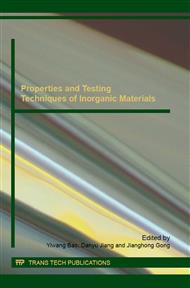p.331
p.335
p.339
p.343
p.347
p.352
p.361
p.365
p.370
Investigation on High-Temperature Creep Properties of High-Alumina Bauxite
Abstract:
This paper studied the high temperature creep properties of high-alumina bauxite (the mass fraction of Al2O3 in the new ore is about 78, the following abbreviations for Al2O3~78). The results indicated that the Al2O3~78 high-alumina bauxite mainly are corundum phase after high temperature sintered.When the temperature is 1100°C, corundum exists as crystal phase and the connections between grains are directly. The creep resistance of samples is very good at this temperature and the creep rate of 50 hours heat preservation is-0.266%. When the temperature is 1200°C, liquid phase starts to produce in a large number and the creep rate in 50 hours heat preservation is-1.589%. When the temperature is 1300°C, because of the further increase on the amount of liquid phase and wetting coated corundum particle, the direct connections between corundum particles are broken and the creep resistance is greatly reduced, the creep rate in 50 hours heat preservation is-4.088%. The creep curve fitting after 25 hours indicated that the creep property shows linear relations in three different temperatures after 25 hours. When the temperature is 1200°C and 1300°C, the creep variables arise rapidly in linear which declare the creep resistance of corundum is poor and increasing with temperature go up, more corundum phase is covered by glass phase and the creep resistance reduces dramatically.
Info:
Periodical:
Pages:
347-351
Citation:
Online since:
February 2016
Authors:
Keywords:
Price:
Сopyright:
© 2016 Trans Tech Publications Ltd. All Rights Reserved
Share:
Citation:


